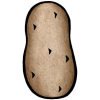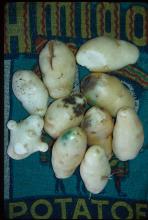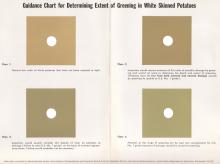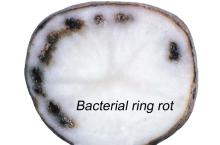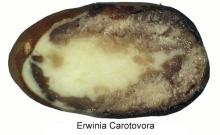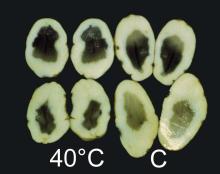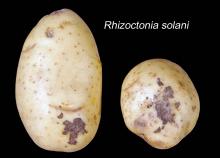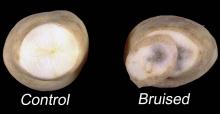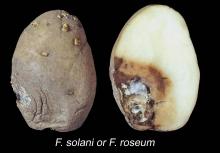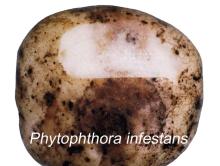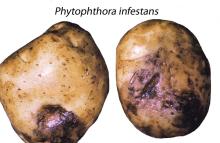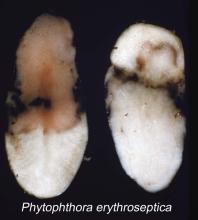Product Description
Maturity and Quality
Immature potatoes, generally harvested in spring or early summer, have a thin, poorly developed periderm, or skin. Irrigation and planting bed management, along with the option of vine-killing treatments, manage harvest "maturity". Harvest preparedness generally begins once tubers have reached a desirable size for the variety or market. Immature potatoes are easily bruised and "skinning" leads to shriveling or decays. They are very perishable relative to late-crop potatoes and are only stored for short periods. Curing potatoes for 8 days at 15°C (59°F) and 95% RH will allow extended storage of up to 5 months at 4°C (39°F) and 95 to 98% RH, depending on variety. More typically, early-crop potatoes are harvested, cooled to 15°C (59°F), treated with a sprouting inhibitor, packed and shipped in a short period of time (i.e. 1 to 5 days).
High quality traits, in commercial trade, include more than 70 to 80% of tubers well shaped, brightness of color (esp. reds, yellows, and whites), uniformity, firmness, freedom from adhering soil, freedom from bruising (black spot or shatter-bruising), scuffing or skinning, growth cracks, sprouting, insect damage, Rhizoctonia Black Scurf, decay, greening, or other defects. Commercial standards in use are typically higher than USDA grade standards. Differentiation of quality for potatoes is very complex.
U.S. Grades: Extra No. 1; No. 1; Commercial; No. 2 (Grade Standards established 1991) Potatoes may be sold as "Unclassified" to designate a lot, which has not been graded within the meaning of U.S. standards.
Postharvest Handling and Storage
| Intended Use | Temperature | % RH |
| Table | 7°C (45°F) | 98 |
| Frying | 10 to 15°C (50-59°F) | 95 |
| Chipping | 15 to 20°C (59-68°F) | 95 |
At optimum conditions, potatoes should have good quality after storage of 3 to 5 weeks. Storing immature potatoes below 10-13°C (50-55°F) for as few as 3 days may cause the accumulation of reducing sugars leading to excessive browning during frying/chipping. Storage for less than 3 weeks is recommended to maintain good visual and sensory quality of immature potatoes.
| Temperature °C | Temperature °F | ml CO2/kg·hr |
| 5 | 41 | 6-8 |
| 10 | 50 | 7-11 |
| 15 | 59 | 7-16 |
| 20 | 68 | 9-23 |
To calculate heat production, multiply ml CO2/kg·hr by 440 to get BTU/ton/day or by 122 to get kcal/metric ton /day.
Note: Immature potato tubers, which are susceptible to bruising and skinning, can have high respiration rates. Cooler temperatures and/or increased air movement are effective methods to ameliorate.
Potato tubers are not very sensitive to external ethylene. Low levels of external ethylene have been shown to elevate respiration, especially in immature potatoes, and result in weight loss and mild shriveling. After aging for 2-3 months at temperatures above 5°C (41°F) and in the absence of sprouting inhibitor application, low levels of ethylene may retard sprouting. High concentrations of external ethylene may induce sprouting.
Very low; Bruised, cut or otherwise damaged tubers have greatly increased ethylene production rates.
Controlled or modified atmospheres offer little benefit to potato. Periderm development and wound healing is delayed at atmospheres below 5% O2. Injury from low O2 Atmosphere (CA) (<1.5%) or elevated CO2 (>10%) will induce off-odors, off-flavors, internal discoloration, and increased decay.
Temperature & Controlled Atmosphere Photos
Disorders
Blackheart. Rare in early-crop potatoes due to typical marketing practices; In conditions of restricted airflow and high respiration, tubers held above 15°C (rapidly above 20°C) develop an internal brown discoloration which eventually becomes deep black. Insufficient oxygen reaches the interior of the tuber under these conditions.
Black Spot. Responsible for significant postharvest losses, particularly in response to over-fertilization with nitrogen, low soil potassium availability, irregular irrigation, and other pre-harvest practices. Non-pigmented compounds form in the vascular bundle tissue just under the skin during storage. Following severe bruising or cutting, the affected tuber tissue turns reddish, then blue becoming black in 24 to 72 hours. Severity increases with time.Varieties differ significantly in their susceptibility and symptom expression.
Chilling Injury. Storage at temperatures near 0°C (32°F) for a few weeks may result in a mahogany discoloration of internal tissue in some varieties. Much longer periods of storage are generally required for chilling injury.
Greening. Exposure to bright light during postharvest handling, or longer periods (1 to 2 weeks) of low light intensity, can result in the development of chlorophyll in the potato tuber, anatomically a modified stem. Associated with greening, bitter and toxic glycoalkaloids, such as solanine, are formed. Solanine also forms in response to bruising, wounding (including fresh processing followed by storage), and during sprouting. Glycoalkaloids are heat stable and minimally impacted by cooking.
Internal Brown Spot. Internal dry, corky reddish-brown or black spots or sectors. Uneven water management and/or widely fluctuating temperatures induce this calcium uptake deficiency, usually early in tuber development. Uneven water availability may also result in Hollow Heart, a corky cavitation at the center of the tuber.
Harvesting, packing and handling should be done with great care to prevent damage to the highly sensitive, thin-skinned, turgid tubers. Crushing, Pressure Bruising, Brown Spot or Shatter Bruising are common defects and may lead to rapid water loss, shriveling and decay.
Brown Spot. Discoloration just beneath the inner surface of the tuber resulting from bruising or rough handling. See Black Spot.
Freezing Injury. Freezing injury will be initiated at -0.8°C (30.5°F). Symptoms of freezing injury include a water-soaked appearance, glassiness, and tissue breakdown on thawing. Mild freezing may also result in chilling injury.
Diseases are an important source of postharvest loss, particularly in combination,with rough handling and poor temperature control. Three major bacterial diseases and a greater number of fungal pathogens are responsible for, occasionally, serious postharvest losses. The major bacterial and fungal pathogens that cause postharvest losses in transit, storage, and to the consumer are Bacterial Soft-Rot (Erwinia carotovora subsp. carotovora and subsp. atroseptica), Ralstonia (ex Pseudomonas, ex Burkholderi) solanacearum,* Phytophthora infestans (late blight), Fusarium Rot (Fusarium spp.), Pink Rot (Phytophthora spp.), and Water rot (Pythium spp.) Occasionally serious diseases of immature tubers include Pink Eye (Pseudomonas fluorescens) and Grey Mold (Botrytis cinerea).
*Not found in California.
Special Considerations
Potatoes may impart an "earthy" odor to apples and pears if held in storage with low air exchange. Potatoes may acquire an off-flavor from odor volatiles released by other produce items.



